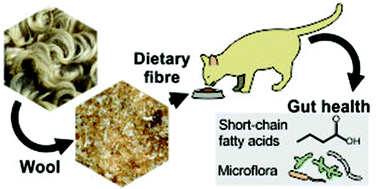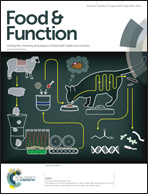The effects of a wool hydrolysate on short-chain fatty acid production and fecal microbial composition in the domestic cat (Felis catus)†
Abstract
Novel animal-derived fibers are of interest for the pet food industry. We here introduce a method for extracting wool proteins using controlled hydrolysis of wool. This results in an appropriate form and we demonstrate its application in pet food using the domestic cat. The effect of the wool hydrolysate on biomarkers of digestive health (e.g., fecal short-chain fatty acids and fecal microbial composition, apparent amino acid (AA) and protein digestibility), are also described. In a feeding study, a cohort of cats (n = 8 per treatment) were fed a basal diet (Control), or the basal diet supplemented with 2% wool hydrolysate, 2% inulin (Synergy1; as is) or 2% cellulose (Novagel; as is). The concentration of butyric acid was not significant (P = 0.102) between treatment groups. The concentration of fecal lactic acid was greatest (P = 0.007) in cats on the Novagel diet. Valeric acid was increased (P = 0.001) in cats fed Synergy1. Supplementation of cat diet with a wool hydrolysate showed similarities to Novagel supplementation in terms of its effects on fecal short-chain fatty acid concentrations and fecal microbiota composition. Wool hydrolysate increased apparent cysteine digestibility compared to Synergy 1 or Novogel. In terms of fecal health, intake, and palatability, the diet supplemented with wool hydrolysate was not detrimental, being similar to currently used dietary fiber supplements. These findings indicate that wool hydrolysates offer promise as an animal-derived supplement source for pet diets.



 Please wait while we load your content...
Please wait while we load your content...